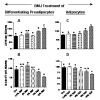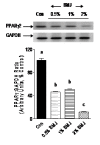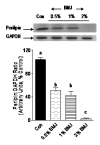Momordica charantia (bitter melon) inhibits primary human adipocyte differentiation by modulating adipogenic genes
- PMID: 20587058
- PMCID: PMC2911406
- DOI: 10.1186/1472-6882-10-34
Momordica charantia (bitter melon) inhibits primary human adipocyte differentiation by modulating adipogenic genes
Abstract
Background: Escalating trends of obesity and associated type 2 diabetes (T2D) has prompted an increase in the use of alternative and complementary functional foods. Momordica charantia or bitter melon (BM) that is traditionally used to treat diabetes and complications has been demonstrated to alleviate hyperglycemia as well as reduce adiposity in rodents. However, its effects on human adipocytes remain unknown. The objective of our study was to investigate the effects of BM juice (BMJ) on lipid accumulation and adipocyte differentiation transcription factors in primary human differentiating preadipocytes and adipocytes.
Methods: Commercially available cryopreserved primary human preadipocytes were treated with and without BMJ during and after differentiation. Cytotoxicity, lipid accumulation, and adipogenic genes mRNA expression was measured by commercial enzymatic assay kits and semi-quantitative RT-PCR (RT-PCR).
Results: Preadipocytes treated with varying concentrations of BMJ during differentiation demonstrated significant reduction in lipid content with a concomitant reduction in mRNA expression of adipocyte transcription factors such as, peroxisome proliferator-associated receptor gamma (PPARgamma) and sterol regulatory element-binding protein 1c (SREBP-1c) and adipocytokine, resistin. Similarly, adipocytes treated with BMJ for 48 h demonstrated reduced lipid content, perilipin mRNA expression, and increased lipolysis as measured by the release of glycerol.
Conclusion: Our data suggests that BMJ is a potent inhibitor of lipogenesis and stimulator of lipolysis activity in human adipocytes. BMJ may therefore prove to be an effective complementary or alternative therapy to reduce adipogenesis in humans.
Figures







Similar articles
-
Polygonum cuspidatum inhibits pancreatic lipase activity and adipogenesis via attenuation of lipid accumulation.BMC Complement Altern Med. 2013 Oct 25;13:282. doi: 10.1186/1472-6882-13-282. BMC Complement Altern Med. 2013. PMID: 24160551 Free PMC article.
-
Myricetin suppresses differentiation of 3 T3-L1 preadipocytes and enhances lipolysis in adipocytes.Nutr Res. 2015 Apr;35(4):317-27. doi: 10.1016/j.nutres.2014.12.009. Epub 2015 Jan 8. Nutr Res. 2015. PMID: 25724338
-
Suppression of adipocyte differentiation and lipid accumulation by stearidonic acid (SDA) in 3T3-L1 cells.Lipids Health Dis. 2017 Sep 25;16(1):181. doi: 10.1186/s12944-017-0574-7. Lipids Health Dis. 2017. PMID: 28946872 Free PMC article.
-
Ginsenoside F2 possesses anti-obesity activity via binding with PPARγ and inhibiting adipocyte differentiation in the 3T3-L1 cell line.J Enzyme Inhib Med Chem. 2015 Feb;30(1):9-14. doi: 10.3109/14756366.2013.871006. Epub 2014 Mar 25. J Enzyme Inhib Med Chem. 2015. PMID: 24666293
-
Grape skin extract reduces adipogenesis- and lipogenesis-related gene expression in 3T3-L1 adipocytes through the peroxisome proliferator-activated receptor-γ signaling pathway.Nutr Res. 2012 Jul;32(7):514-21. doi: 10.1016/j.nutres.2012.06.001. Epub 2012 Jul 18. Nutr Res. 2012. PMID: 22901559
Cited by
-
A detailed review on the phytochemical profiles and anti-diabetic mechanisms of Momordica charantia.Heliyon. 2022 Apr 6;8(4):e09253. doi: 10.1016/j.heliyon.2022.e09253. eCollection 2022 Apr. Heliyon. 2022. PMID: 35434401 Free PMC article. Review.
-
Plant natural products as an anti-lipid droplets accumulation agent.J Nat Med. 2014 Apr;68(2):253-66. doi: 10.1007/s11418-014-0822-3. Epub 2014 Feb 19. J Nat Med. 2014. PMID: 24550097 Free PMC article. Review.
-
Bitter melon juice activates cellular energy sensor AMP-activated protein kinase causing apoptotic death of human pancreatic carcinoma cells.Carcinogenesis. 2013 Jul;34(7):1585-92. doi: 10.1093/carcin/bgt081. Epub 2013 Mar 8. Carcinogenesis. 2013. PMID: 23475945 Free PMC article.
-
Bitter Melon (Momordica charantia) Extract Inhibits Tumorigenicity and Overcomes Cisplatin-Resistance in Ovarian Cancer Cells Through Targeting AMPK Signaling Cascade.Integr Cancer Ther. 2016 Sep;15(3):376-89. doi: 10.1177/1534735415611747. Epub 2015 Oct 19. Integr Cancer Ther. 2016. PMID: 26487740 Free PMC article.
-
Inhibition of Differentiation of 3T3-L1 Cells by Increasing Glioma-Associated Oncogene Expression in Chrysanthemum indicum L. Using Lactococcus lactis KCTC 3115.Prev Nutr Food Sci. 2024 Dec 31;29(4):533-545. doi: 10.3746/pnf.2024.29.4.533. Prev Nutr Food Sci. 2024. PMID: 39759806 Free PMC article.
References
-
- Low S, Chin MC, Deurenberg-Yap M. Review on epidemic of obesity. Ann Acad Med Singapore. 2009;38:57–59. - PubMed
-
- Adipocyte Biology. 4th International Conference on Nutrition and HIV infection and the 2nd European Workshop on Lipodystrophy; April, 19-21; Cannes, France. 2001.
-
- Gregoire FM. Adipocyte differentiation: From fibroblast to endocrine cell. Exp Biol Med (Maywood) 2001;226:997–1002. - PubMed
-
- Wakabayashi K, Okamura M, Tsutsumi S, Nishikawa NS, Tanaka T, Sakakibara I, Kitakami J, Ihara S, Hashimoto Y, Hamakubo T. The peroxisome proliferator-activated receptor gamma/retinoid X receptor alpha heterodimer targets the histone modification enzyme PR-Set7/Setd8 gene and regulates adipogenesis through a positive feedback loop. Mol Cell Biol. 2009;29:3544–3555. doi: 10.1128/MCB.01856-08. - DOI - PMC - PubMed
Publication types
MeSH terms
Substances
Grants and funding
LinkOut - more resources
Full Text Sources
Other Literature Sources

